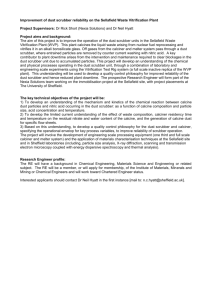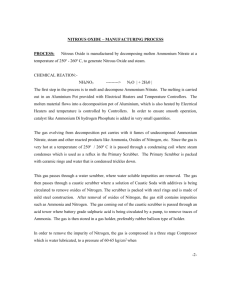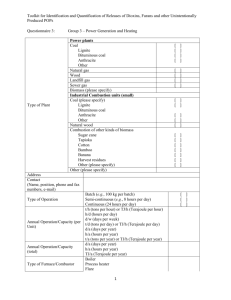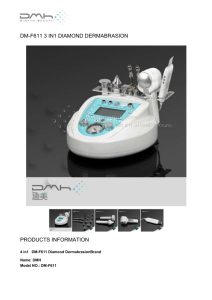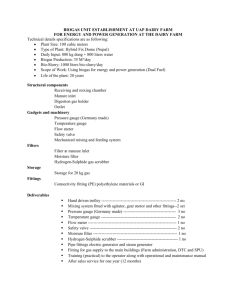frp packed bed horizontal scrubber
advertisement
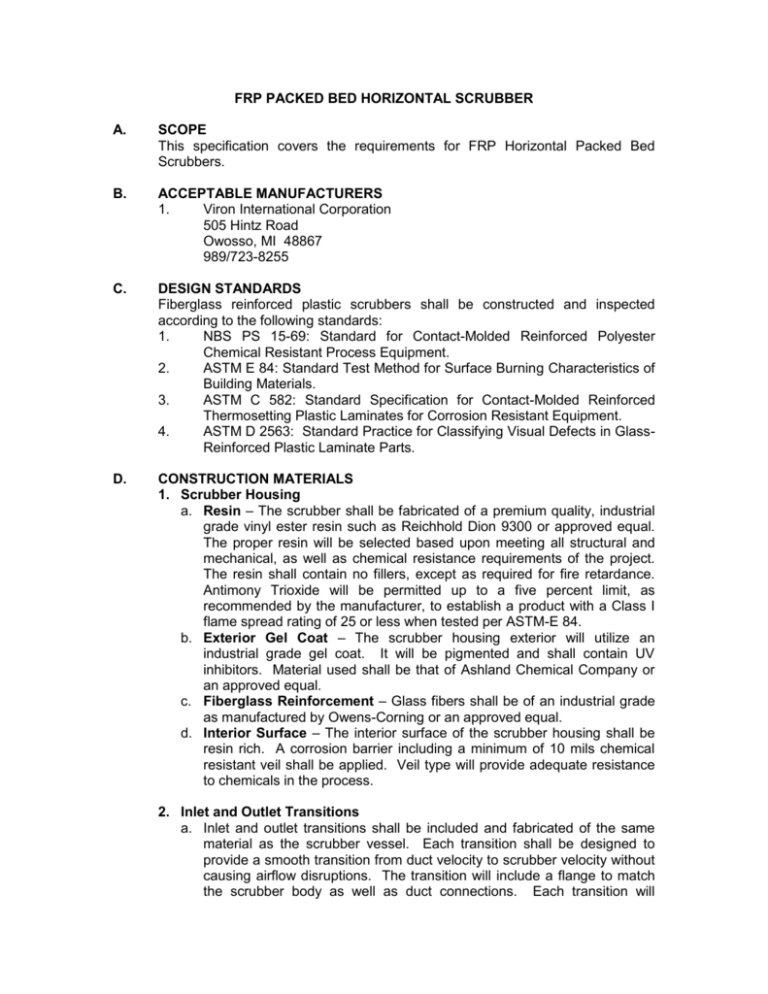
FRP PACKED BED HORIZONTAL SCRUBBER A. SCOPE This specification covers the requirements for FRP Horizontal Packed Bed Scrubbers. B. ACCEPTABLE MANUFACTURERS 1. Viron International Corporation 505 Hintz Road Owosso, MI 48867 989/723-8255 C. DESIGN STANDARDS Fiberglass reinforced plastic scrubbers shall be constructed and inspected according to the following standards: 1. NBS PS 15-69: Standard for Contact-Molded Reinforced Polyester Chemical Resistant Process Equipment. 2. ASTM E 84: Standard Test Method for Surface Burning Characteristics of Building Materials. 3. ASTM C 582: Standard Specification for Contact-Molded Reinforced Thermosetting Plastic Laminates for Corrosion Resistant Equipment. 4. ASTM D 2563: Standard Practice for Classifying Visual Defects in GlassReinforced Plastic Laminate Parts. D. CONSTRUCTION MATERIALS 1. Scrubber Housing a. Resin – The scrubber shall be fabricated of a premium quality, industrial grade vinyl ester resin such as Reichhold Dion 9300 or approved equal. The proper resin will be selected based upon meeting all structural and mechanical, as well as chemical resistance requirements of the project. The resin shall contain no fillers, except as required for fire retardance. Antimony Trioxide will be permitted up to a five percent limit, as recommended by the manufacturer, to establish a product with a Class I flame spread rating of 25 or less when tested per ASTM-E 84. b. Exterior Gel Coat – The scrubber housing exterior will utilize an industrial grade gel coat. It will be pigmented and shall contain UV inhibitors. Material used shall be that of Ashland Chemical Company or an approved equal. c. Fiberglass Reinforcement – Glass fibers shall be of an industrial grade as manufactured by Owens-Corning or an approved equal. d. Interior Surface – The interior surface of the scrubber housing shall be resin rich. A corrosion barrier including a minimum of 10 mils chemical resistant veil shall be applied. Veil type will provide adequate resistance to chemicals in the process. 2. Inlet and Outlet Transitions a. Inlet and outlet transitions shall be included and fabricated of the same material as the scrubber vessel. Each transition shall be designed to provide a smooth transition from duct velocity to scrubber velocity without causing airflow disruptions. The transition will include a flange to match the scrubber body as well as duct connections. Each transition will include two (2); 18” x 18” clear viewing access windows located appropriately to allow viewing the packed bed and entrainment separator. E. LIQUID RECIRCULATION SYSTEM The recirculation system shall be integral and self-contained with the scrubber and shall be designed to pump the required scrubbing solution from the sump to the spray headers, as determined by the surface area of the packing material and the scrubbing efficiency. 1. Piping – All piping and fittings shall be Schedule 80 CPVC. Piping temperature service rating will be a minimum of 210º F. 2. Spray Nozzles – The type of nozzle will be chosen by application requirements. All nozzles are to be PVC with service ratings up to 140º F temperature. Nozzles will be manufactured by BEX Spray Nozzles or equal. 3. Spray Headers – The spray header shall be fabricated using Schedule 80 CPVC. Each spray header will be designed to carry the appropriate liquid flow to insure proper liquid loading rates across the scrubber packing and shall include true union type ball valves to facilitate removal without having to shut down the recirculation system. 4. Pumps – The recirculation pumps will be vertical units directly mounted to the scrubber sump box and pre-plumbed. The recirculation system shall consist of two (2) pumps. One (1) pump will provide the required flow; one (1) will be sized to provide a 100% back-up recirculation flow. The pumps shall be constructed of acid and caustic resistant materials compatible with the solution being pumped. The pump shall be designed to operate within the optimum range of the slope of the pump characteristic curve with an impeller in the midrange of the available sizes for the particular pump. The recirculation pumps shall be 316 stainless steel construction Vertiflo or equal. 5. Plumbing Accessories – A check valve will be provided at each recirculation pump discharge. A true union ball valve will be supplied at each spray header. Butterfly isolation valves will be provided at the discharge of each recirculation pump, before and after the basket strainer and within a bypass line for the basket strainer. All valves shall be constructed of Schedule 80 CPVC material and all wetted parts will be resistant to process chemicals. All valves will be Spears or equal. F. PACKING AND SUPPORT 1. Minimum bed depth to meet efficiencies detailed within this specification. 2. Packing material shall be a hollow, spherical geometric shape designed for turbulent mixing of liquid and gas. Packing will be constructed of a network of ribs, struts, and flat surfaces to achieve the highest surface area contact and flow distribution possible. The packing shall be manufactured from polypropylene or other material, which is suited for the chemical environment. Packing material shall be Jaeger Products 2-inch diameter Tri-Packs or equal. 3. The packed bed shall be designed with a maximum pressure drop per foot of 0.25 inch WC at a superficial velocity of 410 fpm. 4. The scrubber shall be designed and manufactured with a minimum of 80” pack. G. ENTRAINMENT SEPARATOR 1. The scrubber shall have an impingment-type entrainment separator of chevron design suitable for horizontal flow and located in the outlet section of the scrubber prior to gas discharge. 2. The entrainment separator shall be capable of removing in excess of 99 percent of the entrained droplets larger than 15-micron diameter on a total weight basis. The pressure drop through the mist eliminator shall not exceed 0.75 inch WC at maximum operating airflow rates. 3. The entrainment separator will be configured in a cartridge assembly to allow removal for cleaning and replacement. The scrubber entrainment section will include a bolt-on access door on each side of the transition to facilitate easy removal of the cartridge. The cartridge will be provided in a minimum of four (4) pieces. H. ACCESSORIES 1. Nozzles/Couplings – All connections through the scrubber body shall be integrally attached flange or coupling connections. Bulkhead fittings will not be permitted. 2. Hold Down Lugs – Provide hold down lugs for anchoring the scrubber to the concrete pad. The scrubber shall have a fixed-location lug system consisting of at least four (4) evenly spaced lugs. The lugs shall be 304L stainless steel. 3. Names Plates – Permanently attached equipment identification tags will be supplied with the scrubber. Equipment labels shall include: a. Equipment name. b. Equipment identification tag number. c. Design capacity, cfm, static pressure loss (WC). d. Name of manufacturer, model, and serial number. e. Date built. 4. Basket Strainer – A basket strainer shall be provided between the recirculation pump discharge and spray headers. The strainer will have a minimum 6 to1 ratio of open area through the strainer basket to the corresponding pipe cross-section. The basket strainer will include a threaded top for easy access, and a bottom clean-out plug. The cover-tobody seal will be an o-ring of material resistant to system present chemicals. The body of the strainer shall be CPVC material with flanged connections and a 316 stainless steel basket. The basket strainer shall be Hayward or equal. 5. Side View Windows – Viewing windows shall be supplied in each transition for visual inspection of the packing and the entrainment separator, between the packing and entrainment separator, between each spray header, and at each end of the spray chamber. The view windows will be fabricated the same material as the scrubber and shall include a bolt on, clear PVC access window. A polypropylene slide gate shall be provided to separate the process from the view window and shall have a gasket seal to prevent process gas or liquid from leaving the scrubber. 6. Hinged Weir Cover – The scrubber sump will include a hinged polypropylene cover to provide access to the overflow weir. The cover hinges and handle will be constructed of polypropylene material. 7. Pressure Gauge – A valved pressure gauge shall be provided within the scrubber recirculation plumbing between the pump discharge and the spray 8. 9. 10. 11. 12. of each recirculation pump. Each gauge will be conveniently located to facilitate viewing from floor level. Each gauge will be provided with a corrosion-resistant gauge guard. Pump discharge pressure at design operating parameters shall e displayed at mid-range of the gauge. The pressure gauge connection will include a PVC true union ball valve for gauge isolation. The pressure gauge shall be Ashcroft or equal. Flowmeter – Each spray header shall include a rate indicating flow meter rated to operate at the mid-range of capability during design operating conditions. Each flow meter shall be independent. Each flow sensor will be constructed of a material capable of withstanding process chemicals and shall be of paddlewheel design. The flow meter display shall be mounted on the side of the scrubber with sufficient access to make conduit connections and repairs. Each flow meter display will be removable for repair and/or replacement. Each flow meter will operate on an independent 12 to 24 VDC power supply and be capable of providing a 4 to 20 mA output. Flow meters and sensors shall be Signet or equal. pH Control – a. A submersible pH probe shall be supplied to monitor scrubber recirculated water pH. The pH robe will be accessible through the sump box cover without shutting down the recirculation system. The pH probe will be constructed of a material capable of withstanding process chemicals. The pH probe shall have a minimum signal range of 125 feet at an accuracy of 1 percent. b. A pH controller compatible with the pH probe shall be supplied to monitor pH. The controller will operate on an independent 12 to 24 VDC power supply and be capable of providing a 40 to 20mA output. The controller will have a minimum of two (2) alarm outputs. The pH controller shall be installed in a NEMA 4 enclosure. The pH controller shall be Signet or equal. The pH probe shall be Signet or equal. c. A chemical metering pump will be provided to inject neutralizing chemical into the scrubber sump. The metering pump shall be capable metering sufficient chemical to meet scrubber efficiency design parameters and will be chemically resistant to concentrated sodium hydroxide and sulfuric acid. The metering pump will include manual control of frequency and stroke length and will be capable of receiving a 4 – 20 mA pulse signal from the pH controller. The pump will operate on an independent 120 VAC power supply. The metering pump shall be Iwaki or equal. Electric Solenoid Valve – An electric operated solenoid valve shall be supplied for blowdown water. The valve will be constructed of PVC material and will operate on 120 VAC power. The electric solenoid valve shall be Asco or equal. Blowdown Rotameter – A non-powered rotameter type flow indicator will be provided for the blowdown system. The rotameter shall be designed to operate at the mid-range of capability during design operating conditions. Rotameter internals and process connections shall be of material resistant to system present chemicals. The rotameter will provide a direct reading, indelible scale for gpm. Process connections shall be NPT threaded connections. The flow indicator shall be King Instruments or equal. Hardware – Al hardware shall be 316 stainless steel. I. INSPECTION AND TESTING PRIOR TO SHIPMENT 1. Inspection – Inspect all FRP components after fabrication and final cure per ASTM D 2563. 2. Compliance Check - Verify scrubber dimensional accuracy with respect to shop drawings. 3. Repair – Unacceptable nonstructural defects will be repaired by grinding out the defect and reapplying the corrosion barrier. Structural integrity shall not be violated during these repairs. Structural defect repair procedures require prior review by the engineer. Prior to repairing structural defects, notify the Engineer in writing of the defect type, location, and size, and describe the proposed repair procedure. 4. Testing – Testing shall be performed as described below and as necessary to ensure safe and reliable operation. a. Pre-assembly for fit: The scrubber shall be completely assembled to ensure proper fit clearance, maintenance, access, etc. The number of pieces shipped disassembled shall be kept to a minimum, and each piece shall be clearly labeled for assembly. Detailed shop drawings shall accompany the shipment to aid in assembly. b. Hydraulic test at a minimum shall include testing of the sump and piping. The scrubber sump shall be tested by filling with water and visually inspecting for leaks. The piping leak test will include filling the recirculation piping and visually inspecting for leaks. Leak testing will be conducted for a minimum of four (4) hours. c. The scrubber shall be filled with water and the recirculation system operated for a minimum of six (6) hours to demonstrate proper operation of the liquid distribution system. Each of the pumps shall be operated for a minimum of two (2) hours. Verify proper distribution; pump capacity and head for each recirculation pump. d. All test results shall be fully documented in writing and available upon request by the Engineer. e. After completion of testing, the scrubber and piping shall be completely drained of water and prepared for shipment. f. The Owner and Engineer may witness the inspections and tests. Notify Owner and Engineer at least one (1) week prior to inspection. End of Section
